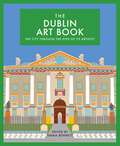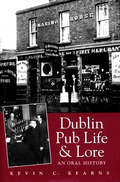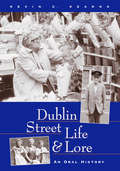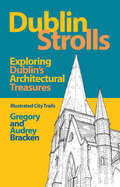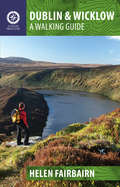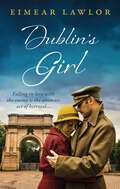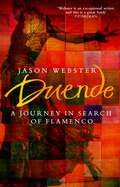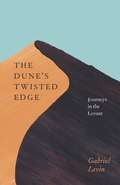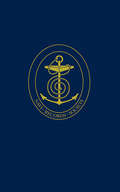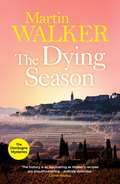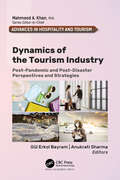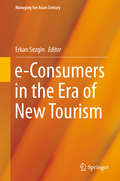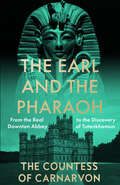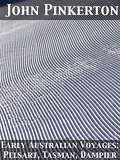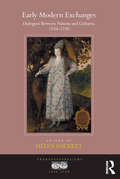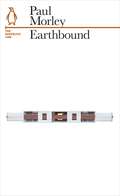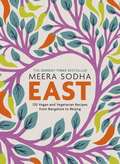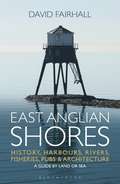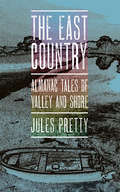- Table View
- List View
The Dublin Art Book: The city through the eyes of its artists (The city through the eyes of its artists)
by Emma BennettA tribute to Ireland's beautiful capital from its own artists.Dublin is an iconic city loved the world over. Visitor or local you will understand why this is. If you have never had the chance to visit, pack your bags immediately! The Dublin Art Book offers a fresh perspective on the city, through the eyes of 55 local artists it inspires.This book is a tribute to Dublin, an impressive artistic collection taking the reader on a tour through this most vibrant city. From historic Trinity College and the iconic Ha'penny Bridge to the lively pub scene and secret hidden corners, Dublin's artists highlight its beauties in the most unique way.
Dublin Pub Life and Lore – An Oral History of Dublin’s Traditional Irish Pubs: The Recollections of Dublin’s Publicans, Barmen and ‘Regulars’
by Kevin C. KearnsDublin is renowned for its amazing profusion of pubs and for its exuberant pub culture. In Dublin Pub Life and Lore, Professor Kevin Kearns examines the history of this phenomenon by speaking to old publicans, barmen and regular customers, relating the story of Dublin pubs and their patrons in an engaging and entertaining fashion.Traditionally in Ireland, the public house or ‘pub’ was the centre of a community’s social life and a social institution ranking second in importance only to the parish church. Pubs ranged from dusky watering holes frequented by labourers, dockers and shawlies to elegant Victorian gin palaces where the gentry and literati gathered. Along the Dublin quays there were dives filled with scoundrels, prostitutes and misfits of every sort. Following the success of his bestselling classic Dublin Tenement Life, Kevin Kearns has researched and created a wonderful oral historical chronicle of Dublin’s pub life. Based on conversations with old publicans, pub ‘regulars’ and long-serving barmen, Dublin Pub Life and Lore captures the folklore, customs, characters and wit of the traditional Dublin public house.Dublin Pub Life and Lore: Table of ContentsIntroductionHistory and Evolution of Dublin Public HousesOrigins and Uses of AlcoholA City of Taverns and AlehousesDublin’s Colourful Public HousesDrinking Customs of the Social ClassesDisreputable Drinking DensProud and Prosperous PublicansDublin Temperance MovementGovernment Inquiry into Intemperance and the Role of Public HousesOral History and Pub LoreDublin Pub Culture and Social LifeThe Pub as a Living Social InstitutionThe Publican’s Role and StatusPub Regulars and Their LocalPorters, Apprentices and BarmenPubs as IRA Meeting PlacesWomen on the “Holy Ground” The Pintman and His PintPub Customs and TraditionsPub EntertainmentSinging PubsLiterary PubsNotable Pub CharactersEccentric Publicans and Notorious PubsUnderworld of Shebeens, Kips and SpeakeasiesFamous Barmen’s StrikesTransformation and Desecration of Venerable PubsOral Testimony of Publicans and BarmenOral Testimony of Pub Regulars and Observers
Dublin Street Life and Lore – An Oral History of Dublin’s Streets and their Inhabitants: The Recollections of Dublin’s Tram Drivers, Lamplighters and Street Dealers
by Professor Kevin C. KearnsThe first half of this century was the heyday of Dublin’s vibrant and bustling traditional street life. Now in Dublin’s Street Life and Lore, through the vivid oral histories of the participants themselves, Professor Kevin Kearns chronicles this rich street life and lore for future generations.The fascinating and often poignant verbal testimonies of Dublin’s last surviving tram drivers, lamplighters, market traders, street dealers, spielers, buskers, local characters and others of their vanishing breed, comprise a wholly original and captivating personal historical record of Dublin’s long renowned street life, told in Professor Kearns’s uniquely engaging and informative style.Dublin Street Life and Lore: Table of ContentsIntroductionDublin Street Life and Oral UrbanloreHistorical Perspectives on Dublin Street TypesStreet Figures of YesteryearLamplightersDockersPostmenChimney SweepSignwriterPawnbrokerFortune TellerDealers, Spielers, Vendors and CollectorsMarket and Street DealersSpielerNewspaper VendorsScrap CollectorsTransport and Vehicles MenJarveysTram DriversPioneer CabbieBicycle and Car ParkersBusmanAnimal Dealers, Drovers and FanciersDroversHorse DealersPig RaiserBird Market MenPigeon FanciersEntertainers and PerformersBuskersPavement ArtistsMimes and ClownsBardic Street Poets
Dublin Strolls: Exploring Dublin's Architectural Treasures
by Gregory Bracken Audrey BrackenThis handy guide to Dublin’s architecture is filled with easy-to-follow walks through the city, with clear maps, expert architectural insights and fascinating historical detail. Dublin’s long history has had a visible impact on its architecture: waves of invaders and the attempts by Dubliners to shake them off have left their mark, with the 1916 Easter Rising, for example, having left whole parts of the city in ruins. It was not all strife, however: the Georgian era saw gracious streets and squares being laid out. This book invites you to emulate Leopold Bloom in strolling through the city. Each walk follows on from the one before and gives clear architectural descriptions, accompanied by beautiful hand-drawn illustrations. Discover: - Hidden Dublin (including Isolde’s Tower, the remains of a 13th-century defence tower discovered in the 1990s along with the skulls of a number of young men whose heads had been displayed on spikes) - Religious buildings (from Christ Church to the burial place of St Valentine) - The buildings involved in the 1916 Rising (including the Royal College of Surgeons, City Hall, Liberty Hall, Kilmainham Gaol and, of course, the GPO). "Stands apart from similar guide books to Dublin principally for its high level of architectural detail on the city’s buildings and its tasteful architectural sketches." – The Irish Times. "Uncovers some fascinating – and forgotten – histories." – Irish Independent. "Not only a guide to some slick architectural trails around the city, but also an absolute MINE of titbits about our fantastic city." – Lovin' Dublin. "A vibrant treasure hunt." – Dublin Inquirer. "Enlightening and inspiring." – The Herald
Dublin & Wicklow: A Walking Guide (A Walking Guide)
by Helen Fairbairnl show you the way! • Also by this author: 'Northern Ireland: A Walking Guide'. For a complete list of walking guides available from The Collins Press, see www.collinspress.ie
Dublin's Girl
by Eimear LawlorFalling in love with the enemy is the ultimate act of betrayal... 1917. A farm girl from Cavan, Veronica McDermott is desperate to find more to life than peeling potatoes. Persuading her family to let her stay with her aunt and uncle in Dublin so she can attend secretarial college, she has no idea what she is getting into. Recruited by Fr Michael O'Flanagan to type for Eamon De Valera, Veronica is soon caught up in the danger and intrigue of those fighting for Ireland's independence from Britain.The attentions of a handsome British soldier, Major Harry Fairfax, do not go unnoticed by Veronica's superiors. But when Veronica is tasked with earning his affections to gather intelligence for Sinn Féin, it isn't long before her loyalty to her countrymen and her feelings for Harry are in conflict. To choose one is to betray the other...Inspired by real life events and marking the centenary of the end of the War of Independence, Dublin's Girl is a thrilling historical debut from an exciting new Irish voice. What readers are saying about Dublin's Girl:'This book was reminiscent of Pam Jenoff's WWII novels and carried the suspense and anticipation of Eoin Dempsey's Finding Rebecca... The chemistry between the main characters was incredible' 5* reader review'Loved this!... Full of romance, political intrigue, suspense, and history' 5* blogger review, Arrow Reads'Fantastic read. I have been completely unable to put this one down. I cannot wait to read more by this author' 5* blogger review, Little Miss Book Lover 87'I loved this book and can't wait to read what the author writes next... Very highly recommended!' 5* reader review'Dublin's Girl by Eimear Lawlor is a great historical fiction novel that has romance, political intrigue, suspense, and most definitely action... At first it seems as if it is a historical romance... it has so much more' 5* reader review'Wow... It was exciting and captivating' 5* reader review'I love learning about this time period in Irish history... The plot and the setting drew me in immediately' 4* reader review
Duende: A Journey In Search Of Flamenco
by Jason WebsterHaving pursued a conventional enough path through school and university, Jason Webster was all set to enter the world of academe as a profession. But when his aloof Florentine girlfriend of some years dumped him unceremoniously, he found himself at a crossroads. Abandoning the world of libraries and the future he had always imagined for himself, he headed off instead for Spain in search of duende, the intense emotional state - part ecstasy, part desperation - so intrinsic to flamenco.Duende is an account of his years spent in Spain feeding his obsessive interest in flamenco: he subjects himself to the tyranny of his guitar teacher, practising for hours on end until his fingers bleed; he becomes involved in a passionate affair with Lola, a flamenco dancer (and older woman) married to the gun-toting Vicente, only to flee Alicante in fear of his life; in Madrid, he falls in with Gypsies and meets the imperious Jesús. Joining their dislocated, cocaine-fuelled world, stealing cars by night and sleeping away the days in tawdry rooms, he finds himself spiralling self-destructively downwards. It is only when he arrives in Granada bruised and battered, after two years total immersion in the flamenco lifestyle that he is able to put his obsession into context.In the tradition of Laurie Lee's classic As I Walked Out One Midsummer Morning, Duende charts a young man's emotional coming of age and offers real insight into the passionate essence of flamenco.
The Dune's Twisted Edge: Journeys in the Levant
by Gabriel Levin“How to speak of the imaginative reach of a land habitually seen as a seedbed of faiths and heresies, confluences and ruptures . . . trouble spot and findspot, ruin and renewal, fault line and ragged clime, with a medley of people and languages once known with mingled affection and wariness as Levantine?” So begins poet Gabriel Levin in his journeys in the Levant, the exotic land that stands at the crossroads of western Asia, the eastern Mediterranean, and northeast Africa. Part travelogue, part field guide, and part literary appreciation, The Dune’s Twisted Edge assembles six interlinked essays that explore the eastern seaboard of the Levant and its deserts, bringing to life this small but enigmatic part of the world. Striking out from his home in Jerusalem in search of a poetics of the Fertile Crescent, Levin probes the real and imaginative terrain of the Levant, a place that beckoned to him as a source of wonder and self-renewal. His footloose travels take him to the Jordan Valley; to Wadi Rumm south of Petra; to the semiarid Negev of modern-day Israel and its Bedouin villages; and, in his recounting of the origins of Arabic poetry, to the Empty Quarter of Arabia where the pre-Islamic poets once roamed. His meanderings lead to encounters with a host of literary presences: the wandering poet-prince Imru al-Qays, Byzantine empress Eudocia, British naturalist Henry Baker Tristram, Herman Melville making his way to the Dead Sea, and even New York avant-garde poet Frank O’Hara. When he is not confronting ghosts, Levin finds himself stumbling upon the traces of vanished civilizations. He discovers a ruined Umayyad palace on the outskirts of Jericho, the Greco-Roman hot springs near the Sea of Galilee, and Nabatean stick figures carved on stones in the sands of Jordan. Vividly evoking the landscape, cultures, and poetry of this ancient region, The Dune’s Twisted Edge celebrates the contested ground of the Middle East as a place of compound myths and identities.
The Dune's Twisted Edge: Journeys in the Levant
by Gabriel Levin“How to speak of the imaginative reach of a land habitually seen as a seedbed of faiths and heresies, confluences and ruptures . . . trouble spot and findspot, ruin and renewal, fault line and ragged clime, with a medley of people and languages once known with mingled affection and wariness as Levantine?” So begins poet Gabriel Levin in his journeys in the Levant, the exotic land that stands at the crossroads of western Asia, the eastern Mediterranean, and northeast Africa. Part travelogue, part field guide, and part literary appreciation, The Dune’s Twisted Edge assembles six interlinked essays that explore the eastern seaboard of the Levant and its deserts, bringing to life this small but enigmatic part of the world. Striking out from his home in Jerusalem in search of a poetics of the Fertile Crescent, Levin probes the real and imaginative terrain of the Levant, a place that beckoned to him as a source of wonder and self-renewal. His footloose travels take him to the Jordan Valley; to Wadi Rumm south of Petra; to the semiarid Negev of modern-day Israel and its Bedouin villages; and, in his recounting of the origins of Arabic poetry, to the Empty Quarter of Arabia where the pre-Islamic poets once roamed. His meanderings lead to encounters with a host of literary presences: the wandering poet-prince Imru al-Qays, Byzantine empress Eudocia, British naturalist Henry Baker Tristram, Herman Melville making his way to the Dead Sea, and even New York avant-garde poet Frank O’Hara. When he is not confronting ghosts, Levin finds himself stumbling upon the traces of vanished civilizations. He discovers a ruined Umayyad palace on the outskirts of Jericho, the Greco-Roman hot springs near the Sea of Galilee, and Nabatean stick figures carved on stones in the sands of Jordan. Vividly evoking the landscape, cultures, and poetry of this ancient region, The Dune’s Twisted Edge celebrates the contested ground of the Middle East as a place of compound myths and identities.
The Durham Papers: Selections from the Papers of Admiral Sir Philip Charles Henderson Calderwood Durham G.C.B. (1763-1845) (Navy Records Society Publications)
by Hilary L. RubinsteinAdmiral Sir Philip Durham (1763–1845) was one of the most distinguished and colourful officers of the late Georgian Navy. His lucky and sometimes controversial career included surviving the sinking of HMS Royal George in 1782, making the first conquest of the tricolour flag in 1793 and the last in 1815, and having two enemy ships surrender to him at Trafalgar. A Scot distantly related to Lord Barham, Durham entered the Navy in 1777, serving initially on the American and West Indies stations. He was Kempenfelt's signal officer on HMS Victory during the second battle of Ushant in 1781 and on the Royal George. Making his reputation initially as the daring young master and commander of HMS Spitfire early in the French Revolutionary War, he became a crack frigate captain with a fortune in prize money, and commanded HMS Defiance at Trafalgar, where he was wounded. He ended his war service as Commander-in-Chief, Leeward Islands. En voyage he artfully captured two brand-new French frigates which were subsequently taken into the service of Britain, and during his tenure he won the heartfelt gratitude of local merchants by ridding the surrounding seas of American privateers preying on British trading vessels. True to form, he clashed with the judge of the Vice-Admiralty Court on Antigua and with the general with whom he led a combined naval and military assault on Martinique and Guadeloupe following Napoleon's escape from Elba. He later served as Commander-in-Chief, Portsmouth having resigned his parliamentary seat to do so. Married first to the sister of the Earl of Elgin, of 'Marbles' fame, and secondly to a cousin of 'sea wolf' Lord Cochrane, he was well-known to George III, who as a result of Durham's amusing yet improbable anecdotes, dubbed any tall tale he heard 'a Durham'. This collection of his papers consists mainly of letters and despatches relating to his service in the Channel Fleet, the Mediterranean, and the Leeward Islands. Correspondence with his parents during 1789–1790 reflects his anxieties relating to employment and prospects for promotion when he was a young lieutenant with an illegitimate child to support. The collection, featuring items from and to him, comprises a fascinating and informative set of documents.
The Durham Papers: Selections from the Papers of Admiral Sir Philip Charles Henderson Calderwood Durham G.C.B. (1763-1845) (Navy Records Society Publications #166)
by Hilary L. RubinsteinAdmiral Sir Philip Durham (1763–1845) was one of the most distinguished and colourful officers of the late Georgian Navy. His lucky and sometimes controversial career included surviving the sinking of HMS Royal George in 1782, making the first conquest of the tricolour flag in 1793 and the last in 1815, and having two enemy ships surrender to him at Trafalgar. A Scot distantly related to Lord Barham, Durham entered the Navy in 1777, serving initially on the American and West Indies stations. He was Kempenfelt's signal officer on HMS Victory during the second battle of Ushant in 1781 and on the Royal George. Making his reputation initially as the daring young master and commander of HMS Spitfire early in the French Revolutionary War, he became a crack frigate captain with a fortune in prize money, and commanded HMS Defiance at Trafalgar, where he was wounded. He ended his war service as Commander-in-Chief, Leeward Islands. En voyage he artfully captured two brand-new French frigates which were subsequently taken into the service of Britain, and during his tenure he won the heartfelt gratitude of local merchants by ridding the surrounding seas of American privateers preying on British trading vessels. True to form, he clashed with the judge of the Vice-Admiralty Court on Antigua and with the general with whom he led a combined naval and military assault on Martinique and Guadeloupe following Napoleon's escape from Elba. He later served as Commander-in-Chief, Portsmouth having resigned his parliamentary seat to do so. Married first to the sister of the Earl of Elgin, of 'Marbles' fame, and secondly to a cousin of 'sea wolf' Lord Cochrane, he was well-known to George III, who as a result of Durham's amusing yet improbable anecdotes, dubbed any tall tale he heard 'a Durham'. This collection of his papers consists mainly of letters and despatches relating to his service in the Channel Fleet, the Mediterranean, and the Leeward Islands. Correspondence with his parents during 1789–1790 reflects his anxieties relating to employment and prospects for promotion when he was a young lieutenant with an illegitimate child to support. The collection, featuring items from and to him, comprises a fascinating and informative set of documents.
The Dying Season: The Dordogne Mysteries 8 (The Dordogne Mysteries #8)
by Martin WalkerThe Dordogne town of St Denis may be picturesque and sleepy, but it has more than its fair share of mysteries, as Bruno knows all too well. But when Bruno is invited to the 90th birthday of a powerful local patriarch - a war hero with high-level political connections in France, Russia and Israel - he encounters a family with more secrets than even he had imagined. When one of the other guests is found dead the next morning and the family try to cover it up, Bruno knows it's his duty to prevent the victim from becoming just another skeleton in their closet. Even if his digging reveals things Bruno himself would rather keep buried.Meanwhile, very modern battles are being fought in St Denis between hunters defending their traditions and environmentalists protecting local wildlife. Neither side, it seems, is above the use of violent tactics. At the centre of it all, Bruno must use all his cunning and character to protect his community's future from its present - and its past.
Dynamics of the Tourism Industry: Post-Pandemic and Post-Disaster Perspectives and Strategies (Advances in Hospitality and Tourism)
by Gül Erkol Bayram Anukrati SharmaThe tourism industry is one of the most fragile industries because it can be significantly impacted by outside forces, such as pandemics and health scares, natural disasters and catastrophes, economic crises, political recessions and wars, and more, especially epidemics that occur on a global scale, which can cause societies to weaken or be damaged. This new volume presents collective experiences that explore how the tourism industry is affected by pandemics and natural disasters, offering case studies and strategies to mitigate their harmful impact.
Dynamics of the Tourism Industry: Post-Pandemic and Post-Disaster Perspectives and Strategies (Advances in Hospitality and Tourism)
by Ül Erkol Bayram Anukrati SharmaThe tourism industry is one of the most fragile industries because it can be significantly impacted by outside forces, such as pandemics and health scares, natural disasters and catastrophes, economic crises, political recessions and wars, and more, especially epidemics that occur on a global scale, which can cause societies to weaken or be damaged. This new volume presents collective experiences that explore how the tourism industry is affected by pandemics and natural disasters, offering case studies and strategies to mitigate their harmful impact.
e-Consumers in the Era of New Tourism (Managing the Asian Century #0)
by Erkan SezginThis book focuses on the role of e-consumers and e-marketing in the era of new tourism. It addresses themes such as the tourism "prosumer" at work, the evolution of tourism services, the collaboration and co-creation, as well as the e-complaint behavior of e-consumers in tourism. It also discusses topics such as mobile marketing, gamification as a marketing communication tool, the impact of social media on tourism consumers, and the use of e-loyalty programs in the accommodation sector. Students taking e-marketing and market research courses in tourism can use this work as a source book for the principles of new marketing management. e-Consumers in the Era of New Tourism serves as a helpful resource for practitioners, as well as researchers and students of e-marketing.
The Earl and the Pharaoh: From The Real Downton Abbey To The Discovery Of Tutankhamun
by The Countess CarnarvonEnter a world of ancient secrets, old money, new ambitions and the discovery of priceless treasure in this revelatory new biography.
Early Australian Voyages: Pelsart, Tasman, Dampier
by John PinkertonThe Essential Library presents John Pinkerton's "Early Australian Voyages," a captivating account of true-life stories of courage and daring. Meet the brave explorers who were the first to cross the uncharted seas.
Early Modern Exchanges: Dialogues Between Nations and Cultures, 1550-1750 (Transculturalisms, 1400-1700)
by Helen HackettMarcus Gheeraerts’s portrait of a ’Persian lady’ - probably in fact an English lady in masquing costume - exemplifies the hybridity of early modern English culture. Her surrounding landscape and the embroidery on her gown are typically English; but her head-dress and slippers are decidedly exotic, the inscriptions beside her are Latin, and her creator was an ’incomer’ artist. She is emblematic of the early modern culture of exchange, both between England and its neighbours, and between Europe and the wider world. This volume presents fresh research into such early modern exchanges, exploring how new identities, subjectivities and artefacts were forged in dialogues and encounters between diverse cultures, nations and language communities. The early modern period was a time of creative interactions between cultures and disciplines, and accordingly this is a multidisciplinary volume, drawing together international experts in literature, history, modern and ancient languages and art history. It understands cultural exchange as encompassing both the geographical mobilities of travel and trade and the transmission of ideas across borders and between languages, as enabled by the new technology of print. Sites of exchange were located not only in distant and unfamiliar lands, but also in the bookseller’s shop and the scholar’s study. The volume also explores the productive and complex dialogues between early modern culture and the classical past. The types of exchanges discussed include the linguistic transactions of translation and imitation; interactions between cultural elites, such as monarchs, courtiers and diplomats; and the catalytic influences of particularly mobile or outward-looking individuals and groups. Ranging from the neo-Latin poetry of an English author to the plays of a nun in seventeenth-century New Spain, from royal portraits exchanged in diplomatic negotiations to travelling companions in the Ottoman Empire, the volume sheds new light
Early Modern Exchanges: Dialogues Between Nations and Cultures, 1550-1750 (Transculturalisms, 1400-1700)
by Helen HackettMarcus Gheeraerts’s portrait of a ’Persian lady’ - probably in fact an English lady in masquing costume - exemplifies the hybridity of early modern English culture. Her surrounding landscape and the embroidery on her gown are typically English; but her head-dress and slippers are decidedly exotic, the inscriptions beside her are Latin, and her creator was an ’incomer’ artist. She is emblematic of the early modern culture of exchange, both between England and its neighbours, and between Europe and the wider world. This volume presents fresh research into such early modern exchanges, exploring how new identities, subjectivities and artefacts were forged in dialogues and encounters between diverse cultures, nations and language communities. The early modern period was a time of creative interactions between cultures and disciplines, and accordingly this is a multidisciplinary volume, drawing together international experts in literature, history, modern and ancient languages and art history. It understands cultural exchange as encompassing both the geographical mobilities of travel and trade and the transmission of ideas across borders and between languages, as enabled by the new technology of print. Sites of exchange were located not only in distant and unfamiliar lands, but also in the bookseller’s shop and the scholar’s study. The volume also explores the productive and complex dialogues between early modern culture and the classical past. The types of exchanges discussed include the linguistic transactions of translation and imitation; interactions between cultural elites, such as monarchs, courtiers and diplomats; and the catalytic influences of particularly mobile or outward-looking individuals and groups. Ranging from the neo-Latin poetry of an English author to the plays of a nun in seventeenth-century New Spain, from royal portraits exchanged in diplomatic negotiations to travelling companions in the Ottoman Empire, the volume sheds new light
Earthbound: The Bakerloo Line (Penguin Underground Lines)
by Paul MorleyPaul Morley, author, journalist and cultural commentator, tells the story in Earthbound of post-punk, music and changing times - part of a series of twelve books tied to the twelve lines of the London Underground, as Tfl celebrates 150 years of the Tube with Penguin'The stand-out is Paul Morley's eclectic, headspinning Earthbound ... it mixes memoir and manifesto to create something paradoxical: an obituary for pre-digital ways of experiencing art that's gleeful and inquisitive rather than emptily nostalgic' The Times'Authors include the masterly John Lanchester, the children of Kids Company, comic John O'Farrell and social geographer Danny Dorling. Ranging from the polemical to the fantastical, the personal to the societal, they offer something for every taste. All experience the city as a cultural phenomenon and notice its nature and its people. Read individually they're delightful small reads, pulled together they offer a particular portrait of a global city' Evening Standard'Exquisitely diverse' The Times'Eclectic and broad-minded ... beautifully designed' Tom Cox, Observer'A fascinating collection with a wide range of styles and themes. The design qualities are excellent, as you might expect from Penguin with a consistent look and feel while allowing distinctive covers for each book. This is a very pleasing set of books' A Common Reader blog'The contrasts and transitions between books are as stirring as the books themselves ... A multidimensional literary jigsaw' Londonist'A series of short, sharp, city-based vignettes - some personal, some political and some pictorial ... each inimitable author finds that our city is complicated but ultimately connected, full of wit, and just the right amount of grit' Fabric Magazine'A collection of beautiful books' Grazia[Praise for Paul Morley]:'At his best he's the Brian Eno of the sentence' Time OutCritic and cultural theorist Paul Morley has written books about music history, Joy Division, suicide, the moog synthesiser and the north of England. A contributor to numerous publications from the Face to the Financial Times, a founding member of the Art of Noise, he appears regularly on BBC 2's The Review Show and has presented radio and television documentaries on many subjects including Brian Eno, boredom, the recording studio and Anthony Burgess. He uses an unregistered Oyster Card.
East: 120 Easy and Delicious Asian-inspired Vegetarian and Vegan recipes
by Meera SodhaTHE SUNDAY TIMES BESTSELLERWhether vegan, veggie or simply an avid home cook, this exquisitely designed cookbook is full of simple recipes that will have every reader swooning.'Enticing, inviting and delicious. Vegan and vegetarian dishes that are hard to resist (and why should you?' YOTAM OTTOLENGHI________________________________Modern, vibrant, easy-to-make food. East is a must-have whether you're vegan, vegetarian, or simply want to eat more delicious meat-free food.Drawing from her 'New Vegan' Guardian column, Meera Sodha's collection features brand-new recipes inspired by Asian cuisine - from India to Indonesia, Singapore to Japan, by way of China, Thailand, and Vietnam.With 120 practical and mouth-watering recipes, learn how to make:- ROASTED PANEER ALOO GOBI for a quick Monday-night dinner- CARAMELIZED ONION AND CHILLI RAMEN straight from the store-cupboard- THE SODHA FAMILY MASALA OMELETTE to serve up a home-made brunch- SALTED MISO BROWNIES as a sweet treatThere are seasonal specialities, warming noodles and curries, tofu and rice dishes as well as salads, sides and sweets - all practical and surprisingly easy to make - and bursting with exciting flavours._________________________________'Meera can take a packet of noodles, some peanut butter and a hunk of tofu and work magic. East is the vegetable book for people who aren't vegetarian. A joy - I want to cook every dish' DIANA HENRY'Fabulous' NIGELLA LAWSON'She has a seemingly magic ability to tell you exactly the detail you need to make a dish sing. This book is a godsend' BEE WILSON, SUNDAY TIMES
East Anglian Shores: History, Harbours, Rivers, Fisheries, Pubs and Architecture
by David FairhallFrom Leigh to Lynn – the Thames to the Wash – the coastlines of East Anglia are the most diverse in Great Britain. Norfolk, Suffolk and Essex are communities shaped by their close relationship with the sea and seafaring, from Viking raiders to modern container ships, and hard-working trawlers to elegant racing yachts.In this book, long-time resident David Fairhall explores a landscape that has inspired some of the greatest English painters. He follows gentle rivers that reach far inland from a coastline of marsh, sand and shingle, through fenland and farmland, to rural villages where the past is always present.Rediscovering the East Anglian coastline everyone knows, and uncovering the East Anglian shores only the locals see, this book is written for newcomers and visitors interested in the waterside. It is a treasure trove of local history, endearing wildlife, fascinating architecture and friendly pubs.For anyone whose first impulse on arriving in an unfamiliar town on the coast is to head for the water, this book brings the landscape to life.
East Anglian Shores: History, Harbours, Rivers, Fisheries, Pubs and Architecture
by David FairhallFrom Leigh to Lynn – the Thames to the Wash – the coastlines of East Anglia are the most diverse in Great Britain. Norfolk, Suffolk and Essex are communities shaped by their close relationship with the sea and seafaring, from Viking raiders to modern container ships, and hard-working trawlers to elegant racing yachts.In this book, long-time resident David Fairhall explores a landscape that has inspired some of the greatest English painters. He follows gentle rivers that reach far inland from a coastline of marsh, sand and shingle, through fenland and farmland, to rural villages where the past is always present.Rediscovering the East Anglian coastline everyone knows, and uncovering the East Anglian shores only the locals see, this book is written for newcomers and visitors interested in the waterside. It is a treasure trove of local history, endearing wildlife, fascinating architecture and friendly pubs.For anyone whose first impulse on arriving in an unfamiliar town on the coast is to head for the water, this book brings the landscape to life.
East Coast of Yorkshire Map (tactile)
by RnibThis a tactile diagram for GCSE level students. It covers two pages - the first page is a key with all tactile symbols and labels explained, and the second is a tactile map of the East coast of Yorkshire.
The East Country: Almanac Tales of Valley and Shore
by Jules PrettyThe East Country is a work of creative nonfiction in which the acclaimed nature writer Jules Pretty integrates memoir, natural history, cultural critique, and spiritual reflection into a single compelling narrative. Pretty frames his book around Aldo Leopold and his classic A Sand County Almanac, bringing Leopold’s ethic—that some could live without nature but most should not—into the twenty-first century. In The East Country, Pretty follows the seasons through seventy-four tales set in a variety of landscapes from valley to salty shore. Pretty convinces us that we should all develop long attachments to the local, observing that the land can change us for the better.
